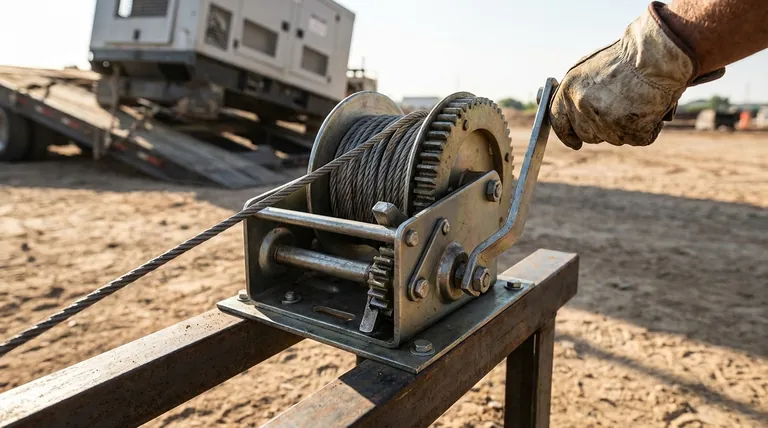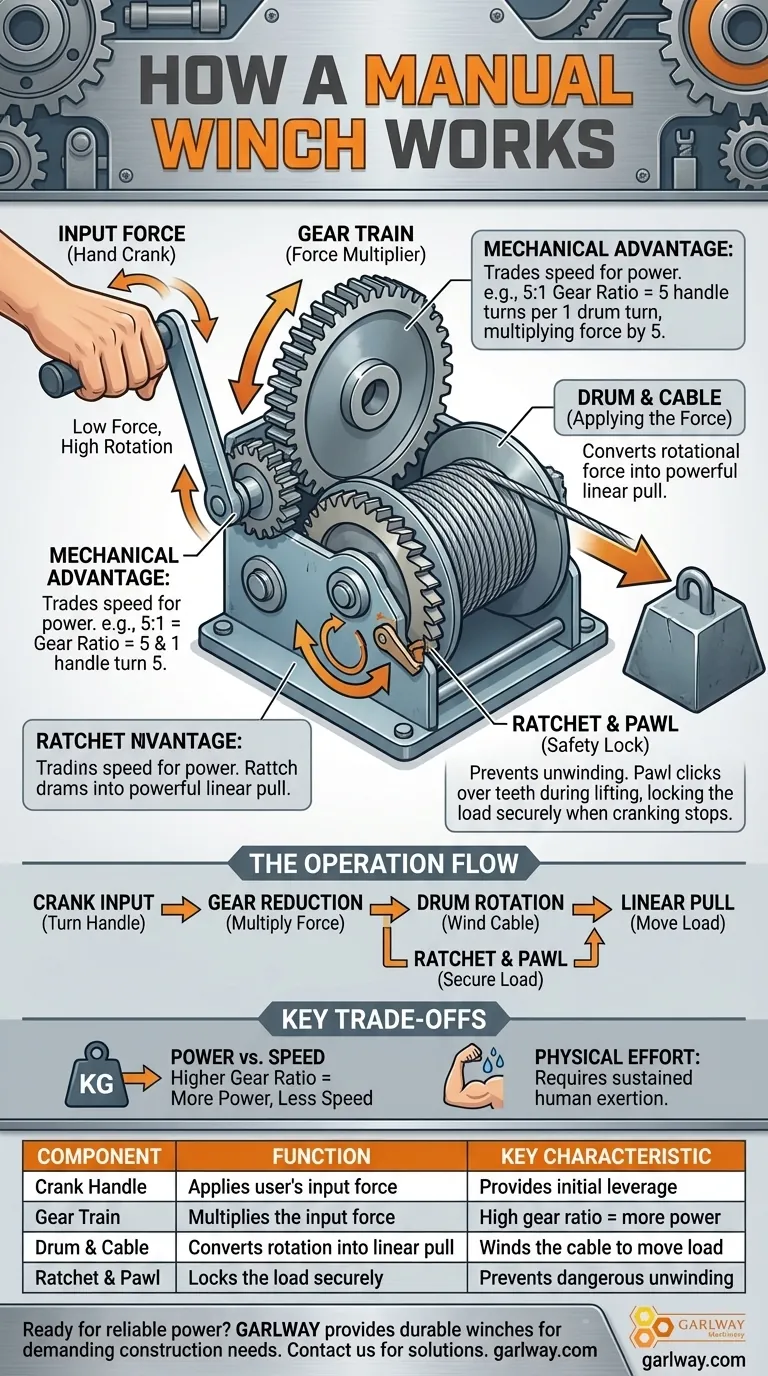At its core, a manual winch is a force multiplier. It works by using a hand crank to turn a set of internal gears. These gears amplify the operator's physical effort, rotating a central drum that winds a cable or rope. This process converts the simple act of turning a handle into a powerful linear pull capable of moving heavy loads.
The essential principle of a manual winch is mechanical advantage. It trades speed for power, using a gear train to transform a low-force, high-rotation input from the hand crank into a high-force, low-rotation output at the winding drum.

The Core Components and Their Roles
To truly understand how a manual winch functions, you must first understand the job of each individual part. Every component serves a distinct purpose in converting your effort into a controlled, powerful pull.
The Crank Handle: Your Input Force
The crank handle is the direct interface between you and the machine. It is the lever you turn to apply your physical energy into the winch's system. The length of the handle provides initial leverage, but the real magic happens inside.
The Gear Train: The Force Multiplier
This is the heart of the winch. The crank handle turns a small gear, which then meshes with and turns a much larger gear. This gear reduction is the source of the winch's power.
For example, a 5:1 gear ratio means you must turn the handle five full times to make the drum rotate only once. While this slows the operation down, it multiplies your input force by five times, allowing you to move loads you could never move by hand.
The Drum and Cable: Applying the Force
The gear train's powerful, slow rotation is transferred to the drum. The drum is the cylinder that neatly winds the steel cable or synthetic rope. As the drum turns, it converts the rotational force into a strong, linear pull on whatever is attached to the end of the cable.
The Ratchet and Pawl: The Safety Lock
The ratchet is a critical safety component. It is a toothed wheel attached to the gear assembly, and a small, spring-loaded lever called a pawl rests against it.
As you crank the winch to pull a load, the pawl clicks over the angled teeth of the ratchet. If you stop cranking, the load's tension tries to pull the drum backward, but the pawl immediately catches a ratchet tooth, preventing it from unwinding. This mechanism holds the load securely in place.
The Complete Operation: From Crank to Pull
Understanding the components allows us to see the entire process as a seamless flow of energy and force.
Winding In (Lifting or Pulling)
When you turn the crank clockwise, you are engaging the gear train and turning the drum. The cable winds tightly onto the drum, pulling the load. With each turn, you hear the reassuring click of the pawl engaging the ratchet, locking your progress and securing the load.
Releasing the Load (Lowering)
To lower or release the load, you typically flip the pawl away from the ratchet wheel. This disengages the safety lock. You can then turn the crank handle counter-clockwise, allowing the drum to unwind in a controlled manner. Some winches incorporate a brake system for even smoother and safer lowering.
Understanding the Trade-offs
A manual winch is a simple and effective tool, but its design is based on fundamental physical trade-offs.
Power vs. Speed
This is the central compromise. A winch with a high gear ratio (e.g., 10:1) will have immense pulling power but will be very slow to operate. A winch with a low gear ratio (e.g., 3:1) will pull the cable in much faster but won't be able to handle extremely heavy loads.
Physical Effort
Despite the mechanical advantage, the "manual" in the name is key. Moving heavy loads still requires significant and sustained physical exertion from the operator. The winch makes it possible, but not effortless.
Mechanical Simplicity
The simple design of a manual winch makes it highly reliable and easy to maintain. However, it also means it lacks the features of powered winches. There are no automatic controls; safety and control depend entirely on the operator and the integrity of the ratchet mechanism.
Making the Right Choice for Your Goal
The purpose of understanding how a winch works is to use it effectively and choose the right one for your specific task.
- If your primary focus is moving very heavy loads (like a boat onto a trailer): Choose a winch with a high gear ratio to maximize your pulling power.
- If your primary focus is speed for lighter tasks (like adjusting tension on a line): A winch with a lower gear ratio or multiple speed settings will be far more efficient.
- If your primary focus is safety and reliability in any scenario: Prioritize a winch with a robust, well-built frame and a simple, positive-locking ratchet system that you can easily inspect.
By understanding these core principles, you can operate a manual winch not just effectively, but with confidence and safety.
Summary Table:
| Component | Function | Key Characteristic |
|---|---|---|
| Crank Handle | Applies user's input force | Provides initial leverage |
| Gear Train | Multiplies the input force | High gear ratio = more power, less speed |
| Drum & Cable | Converts rotation into linear pull | Winds the cable to move the load |
| Ratchet & Pawl | Locks the load securely | Prevents dangerous unwinding |
Ready to harness the power of a reliable manual winch for your project?
GARLWAY specializes in durable construction machinery, including heavy-duty winches, concrete mixers, and batching plants designed for the demanding needs of construction companies and contractors worldwide. Our winches are engineered for maximum pulling power and safety, ensuring your heavy lifting operations are efficient and secure.
Contact GARLWAY today to find the perfect winch solution for your business!
Visual Guide

Related Products
- Ready Mixer Machine for Construction Ready Mix Machinery
- Electric and Hydraulic Winch for Heavy Duty Applications
- Portable Concrete Mixer Machine Equipment for Mixing Concrete
- Warn Winch Windlass Boat Trailer Winch
- JZC400 Mobile Small Concrete Mixer Cement Mixer Machine
People Also Ask
- What should be considered regarding the output of a concrete mixer? Match Capacity to Your Project Scale
- What safety considerations are important for concrete mixer operation? A Guide to Proactive Risk Management
- Can a concrete mixer be used for mortar? Understanding the trade-offs for your project
- Why is cleaning a concrete mixer after use important? Avoid Costly Repairs and Ensure Quality
- Why is the manufacturer's strength and service important when choosing a concrete mixer? Ensure Long-Term Project Success



















